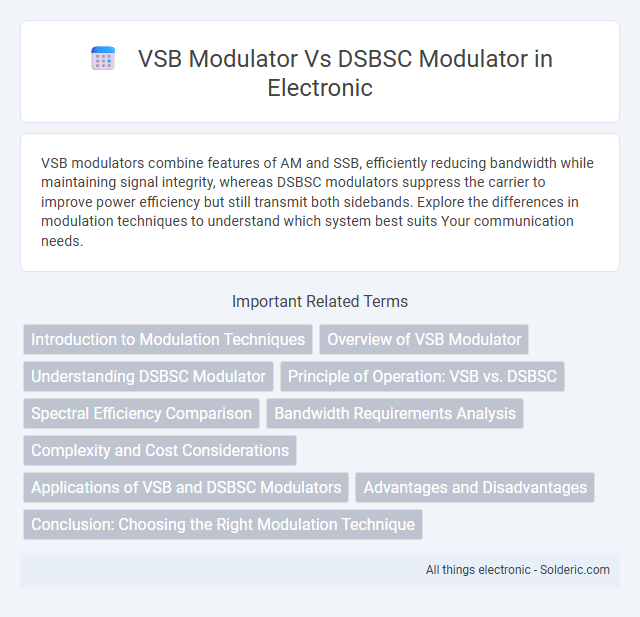VSB modulators combine features of AM and SSB, efficiently reducing bandwidth while maintaining signal integrity, whereas DSBSC modulators suppress the carrier to improve power efficiency but still transmit both sidebands. Explore the differences in modulation techniques to understand which system best suits Your communication needs.
Comparison Table
| Parameter | VSB Modulator | DSBSC Modulator |
|---|---|---|
| Definition | Vestigial Sideband modulation transmits one full sideband and a portion of the other. | Double Sideband Suppressed Carrier transmits two sidebands without the carrier. |
| Bandwidth | Approximately 1.25 times the baseband bandwidth (reduced bandwidth). | Twice the baseband bandwidth (full bandwidth). |
| Carrier Transmission | Carrier suppressed or reduced; carrier recovery is simpler. | Carrier is completely suppressed; requires synchronous detection. |
| Applications | Television broadcasting, especially analog TV. | Point-to-point communication, analog signal transmission. |
| Complexity | Moderate complexity due to filtering vestigial sideband. | Simpler modulator but complex demodulation due to carrier suppression. |
| Power Efficiency | Higher than DSBSC owing to partial sideband transmission. | Moderate power efficiency; no carrier power wasted. |
Introduction to Modulation Techniques
VSB (Vestigial Sideband) modulator and DSBSC (Double Sideband Suppressed Carrier) modulator are essential modulation techniques used in communication systems. VSB modulation transmits one full sideband and a portion of the other, improving bandwidth efficiency while maintaining signal integrity, making it suitable for television broadcasting. DSBSC modulation transmits both sidebands without the carrier, enhancing power efficiency but requiring coherent detection for demodulation.
Overview of VSB Modulator
A Vestigial Sideband (VSB) modulator efficiently transmits a signal by partially suppressing one sideband and allowing a vestige of it to pass, balancing bandwidth reduction with signal fidelity. This type of modulation is commonly used in television broadcasting, offering better spectral efficiency compared to Double Sideband Suppressed Carrier (DSBSC) modulators by minimizing bandwidth without fully eliminating a sideband. Your choice of a VSB modulator ensures improved power efficiency and reduced interference, making it ideal for applications requiring high-quality analog signal transmission.
Understanding DSBSC Modulator
A DSBSC (Double Sideband Suppressed Carrier) modulator transmits both sidebands of the message signal while suppressing the carrier, enhancing power efficiency compared to traditional AM signals. This method ensures that your transmitted signal occupies bandwidth twice the baseband frequency, offering full information content without carrier power wastage. Understanding the structure and operation of a DSBSC modulator aids in implementing efficient communication systems where bandwidth and power conservation are crucial.
Principle of Operation: VSB vs. DSBSC
The VSB (Vestigial Sideband) modulator operates by transmitting one full sideband and a partial vestige of the other sideband to reduce bandwidth while preserving signal integrity, making it highly efficient for TV broadcasting. The DSBSC (Double Sideband Suppressed Carrier) modulator transmits both sidebands symmetrically but suppresses the carrier, optimizing power usage and bandwidth compared to standard AM but requiring coherent detection. VSB modulation balances bandwidth efficiency and ease of demodulation, whereas DSBSC focuses on carrier power elimination and bandwidth equal to double the baseband frequency.
Spectral Efficiency Comparison
VSB modulators provide higher spectral efficiency than DSBSC modulators by transmitting a partially suppressed carrier and only one sideband, reducing the required bandwidth to approximately 75% of a double sideband signal. DSBSC modulators transmit both sidebands without a carrier, consuming nearly twice the bandwidth of a single sideband or vestigial sideband system. Your choice of VSB modulation allows more channels or data to fit within the same spectral space, optimizing spectrum usage for broadcast or communication systems.
Bandwidth Requirements Analysis
A VSB modulator requires significantly less bandwidth than a DSBSC modulator, as it transmits only a vestige of one sideband along with the full carrier, effectively reducing spectrum usage. This partial sideband transmission allows your communication system to maintain signal integrity while optimizing spectral efficiency. In contrast, a DSBSC modulator transmits both sidebands without the carrier, doubling the bandwidth requirement and thus being less efficient in bandwidth-sensitive applications.
Complexity and Cost Considerations
VSB modulators typically exhibit higher complexity and cost due to their selective filtering requirements, which involve precise bandpass filters to achieve the vestigial sideband effect. In contrast, DSBSC modulators use simpler balanced modulators without the need for complex filtering, resulting in lower implementation costs and easier circuit design. The trade-off favors VSB in transmission efficiency but incurs increased hardware and manufacturing expenses compared to the more cost-effective DSBSC approach.
Applications of VSB and DSBSC Modulators
VSB modulators are widely used in television broadcasting to efficiently transmit video signals with reduced bandwidth and minimized interference, making them ideal for analog and digital TV systems. DSBSC modulators find common applications in point-to-point communication systems and suppressed carrier transmission, where bandwidth efficiency and reduced power consumption are crucial. Both modulators serve distinct roles in communication technologies, with VSB excelling in broadcast scenarios and DSBSC preferred in specialized radio frequency communication setups.
Advantages and Disadvantages
VSB modulators offer improved bandwidth efficiency by partially suppressing one sideband while retaining essential information, reducing spectral occupancy compared to DSBSC modulators. DSBSC modulators, while simpler and effective for transmission, suffer from higher power consumption and increased bandwidth requirements as both sidebands carry the same information. The main disadvantage of VSB modulators includes increased system complexity and the need for precise filtering, whereas DSBSC modulators face challenges in power efficiency and susceptibility to noise due to full sideband transmission.
Conclusion: Choosing the Right Modulation Technique
Choosing the right modulation technique depends on your requirements for bandwidth efficiency and signal clarity. VSB modulators provide a balance by reducing bandwidth compared to DSBSC modulators while maintaining better signal quality than AM, making them ideal for TV broadcasting. If bandwidth conservation and minimizing adjacent channel interference are critical, VSB modulation is typically the preferred choice over DSBSC.
VSB modulator vs DSBSC modulator Infographic

 solderic.com
solderic.com